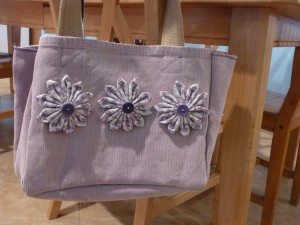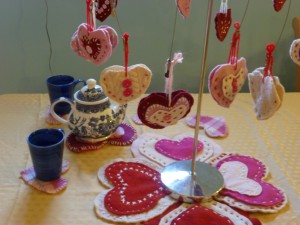I would like take a moment and talk about design. What young people or inexperienced crafters think is that experts can just put it together, it looks awesome and isn’t everyone impressed. This is encouraged by DIY shows and craft gurus. What you don’t see is the 40 flowers that were cut out to get that perfect one. The 4 or 5 mock ups before something is ready for TV. Possibly even a crew of people all making piles and pile of the project in different stages of completion. I don’t have that kind of time, and if you are a hobby crafter you probably don’t either.
So here are some of my design points as illustrated by the laptop cozy from the felting project book that is in development.

Falling flowers laptop cozy
First: Color scheme. Be in a place with good, bright light. Natural sunlight is best. Make a pile of your felt that you want to use. What does the pile look like when you add a bit of unexpected color, like yellow? Remove it? Does anything not look quite right? Remove those colors. This will help you decide based on what you have on hand what looks good together. You will have much more than you need for the project. That is ideal.
Lay the pile out so some pieces show a lot, then change it to only a little show. What looks best to you? This will help you choose which colors will be the most used and least used.
Colors look good together when they are the same value, or tone, or have a common base color (sometimes called a mother color). There is science behind this, but that become boring. At some point you will just know that something looks good, like everything clicks in place.
Not sure about the colors yet? Don’t rush it and take your time. Add or remove colors, for a small piece you want to only have 2 or 3 different fabrics unless you have 20 different fabrics. This is my all or nothing principle. Less is more unless you have a huge amount, then more is more. Try adding in just a little of an unexpected color that is not in your “theme” color, like a little purple to a pile of orange. This can totally transform the look.
Embellishment color: The embellishment color is the perfect way to transform what you are looking at. Trust me when I say that without the little yellow buttons the cozy looks incomplete. I was thinking about pink buttons at first and laid that out, but it just wasn’t right. Use beads or buttons of that color to bring the other colors to life. By using the embellishments to add in this color is highlights the color.
The other secrete to design: Lay everything out first. Does it look complete? Does it give you the feeling that everything is as it should be? If the answer is no, then take a few design elements a way, add them back. Which is better? This is a lot like an eye exam where they ask which lens is better until the two lenses look the same and you can’t tell the difference between the two. You might go through 5 or 10 or 15 layouts. This is the part that they never show on TV. The part where you spend 20 minutes laying something out that isn’t done yet, moving pieces around, adding them back, cutting out more pieces you just spent 20 minutes cutting out before. Changing all the buttons from pink to yellow. Changing them back. You might end up with a pile of pieces that you cut out that you don’t need. That is OK, save them for another project. It is just part of the process. Now pin everything into place, or if you can’t do that because of the steps needed to assemble, take a picture of it with your digital camera to help remind you.
Now, you have something perfect and unique to you.













